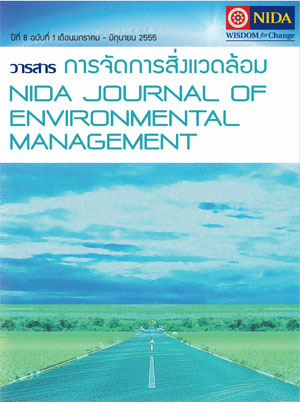การเปลี่ยนแปลงภูมิทัศน์และสถานการณ์ของพื้นที่เกษตรกรรมฝั่งตะวันออกของกรุงเทพมหานครท่ามกลางกระแสความเป็นเมือง Landscape Change and the Situation of Agricultural Land in Eastern Bangkok under Urbanization
บทคัดย่อ
งานวิจัยนี้ศึกษาการเปลี่ยนแปลงภูมิทัศน์อันเป็นสิ่งที่เกิดขึ้นเป็น พลวัตตามธรรมชาติจาก การพัฒนาเมือง โดยเลือกพื้นที่บางชันเป็นพื้นที่ศึกษา เนื่องจากพื้นที่ดังกล่าวได้เผชิญกับกระแสการ เปลี่ยนแปลงจากกระบวนการกลายเป็นเมือง ในการศึกษาปรากฏการณ์ดังกล่าว งานวิจัยนี้อาศัยการ ทำแผนที่เชิงประวัติศาสตร์เป็นเครื่องมือหลักในการศึกษา จากการศึกษาค้นพบว่า พื้นที่บางชันมีการ เปลี่ยนแปลงภูมิทัศน์อย่างมีนัยสำคัญ และสามารถวัดค่าได้จากข้อบ่งชี้ด้านการใช้ประโยชน์ที่ดิน ได้แก่ (1) พื้นที่ปลูกสร้าง (2) พื้นที่เกษตรกรรม และ (3) พื้นที่ว่างรอการพัฒนา ผลการศึกษาความสัมพันธ์ระหว่าง ข้อบ่งชี้ดังกล่าวในเชิงปริมาณกับปัจจัยแวดล้อมในเชิงคุณภาพสรุปได้ว่า การเปลี่ยนแปลงภูมิทัศน์ของ พื้นที่ศึกษานั้นเกิดจากปัจจัยสำคัญคือ (1) การปรับปรุงและเพิ่มขึ้นของถนนระหว่างศูนย์กลางเมืองและ ชานเมือง (2) การเพิ่มขึ้นของจำนวนประชากร (3) การเปลี่ยนแปลงของสิ่งปกคลุมพื้นดิน และ (4) ปัจจัย อื่นๆ ที่อาจมีส่วนทำให้เกิดการเปลี่ยนแปลงภูมิทัศน์ แม้ว่าการศึกษานี้จะไม่สามารถหยุดยั้งกระบวนการ กลายเป็นเมืองในพื้นที่ศึกษาได้ แต่เป้าหมายที่สำคัญของการศึกษานี้คือ การสร้างความตระหนักถึงความ สำคัญของการคงอยู่ของพื้นที่เกษตรกรรมอย่างบางชัน หรือพื้นที่รอยต่อเมืองกับชนบทอื่น ๆ รวมถึงการ มุ่งสร้างคำถามเพื่อต่อยอดทางความคิดและการศึกษาวิจัยเกี่ยวกับปัจจัยของการ เปลี่ยนแปลงภูมิทัศน์ใน เชิงลึกต่อไป
This article studies landscape change, a dynamic and natural phenomenon resulting from urban development. To explore and explain this phenomenon, this study will use the historical mapping and timeline method to concentrate on environmental characterization, both in anthropogenic areas and natural areas in the study area, Bang Chan, one of urban-rural interfaces or fringe areas facing rapid growth and urbanization. According to the analysis of the findings, the landscape change of Bang Chan can be identified by the following indicators: (1) urban or built-up areas; (2) agricultural areas; and (3) other lands, especially prospective lands for future use. Such indicators mentioned can be indicated by using a series of historical maps. Coupled with a timeline analysis, the results show that the factors affecting changes might be: (1) improvement of transportation between the CBD and fringe area; (2) demographic growth; (3) land cover changes from the increase of many housing estates; and (4) other relevant factors which might cause landscape changes, such as socio-cultural, economic, and other physical changes. Though this study cannot stop urbanization in Bang Chan and other similar urban–rural interfaces, the most important aim is to create an awareness of their importance and existence and thus, to raise requirements for in-depth and advanced study in the future.



